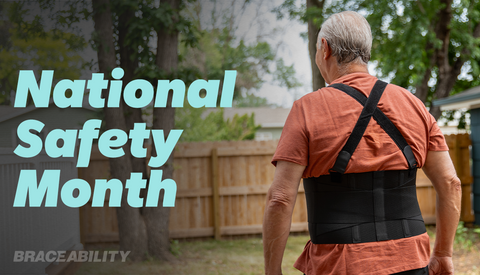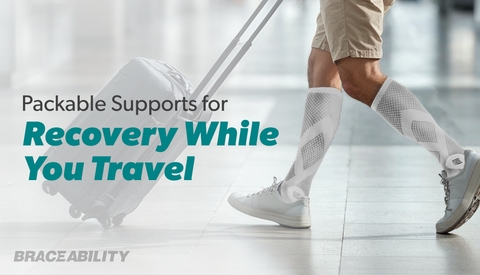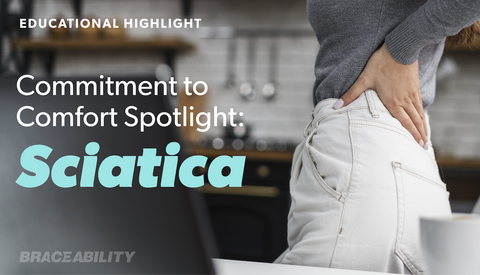Spinal Stenosis - Narrowing of the Spine
What Is Spinal Stenosis?
Your spine consists of 26 bones stacked up on top of each other making your vertebrae. Your spinal column helps to support your spinal cord, which allows you to stand, walk, twist, and move. Each bone in your vertebrae has additional attachments to add more stability and protection of the spinal cord. In between these bones are cushioned discs, which prevent the bones from rubbing up against each other.
Spinal stenosis is the narrowing of the open spaces in your spine, leading to pressure on your spinal cord and the nerves that travel through it. Your spine is divided into three main parts: cervical, thoracic, and lumbar. This condition usually occurs in the lower back (lumbar) and neck of the spine (cervical).

What Are Common Symptoms of Spinal Stenosis?
For some individuals, there are little to no signs or symptoms of thoracic spinal stenosis. For others, they may experience symptoms such as:
- Pain, tingling, or muscle weakness in your back
- Pain developing over time
- Problems with your bladder or bowel functions
- Difficulty walking
- Clumsiness
What Caused Stenosis in my Backbone?
There are many different underlying causes of spinal stenosis. Some people have no control over if they are born with a small spinal canal, making them prone to narrowing of the spine. Other potential causes of spinal stenosis include:
- Herniated discs: The cushions in between the discs over time lose their water content. This creates cracks and results in the soft inside of the discs to “herniate” or push through the cracks pressing on the spinal cords or nerves.
- Aging: This can result in the thickening of ligaments, discs losing their water content, and facet joints breaking down, which can all cause the spaces in the spine to narrow.
- Thickened ligaments: These are the cords that hold the bones of your spine together. Over time, they tend to become thicker, resulting in them bulging into the spinal cord.
- Tumors: These abnormal growths can form inside the spinal cord, causing extra pressure to be put on the spine.
- Hereditary: As mentioned above, some individuals are born with a narrow spinal cord, which may result in spinal stenosis as they grow.
- Spondylolysis: A condition that refers to a defect of the bones in the spine, usually caused by stress fractures.
- Arthritis: Osteoarthritis, a type of arthritis that causes bone spurs and issues with the joints, affecting the spine and causes spinal stenosis.
- Spinal curvature disorders: Such as scoliosis, kyphosis, and lordosis.
- Other injuries to the spine: Trauma such as a car accident or fall may cause dislocation or fractures. These injuries may damage the other parts of the spinal canal resulting in swelling and pressure on the spinal cord and nerves.
Cervical Spinal Stenosis
Cervical spinal stenosis is located in the upper back or neck area of your spine. The cervical area consists of seven bones that connect with the thoracic spine area. This is the second most common area for spinal stenosis and is a result of the spinal canals narrowing and compressing the spinal cord. The most common age for this condition is between 40 and 60 years. It is more common for men to develop cervical spinal stenosis because they tend to do exercises such as weightlifting, which adds extra wear and tear to the discs.
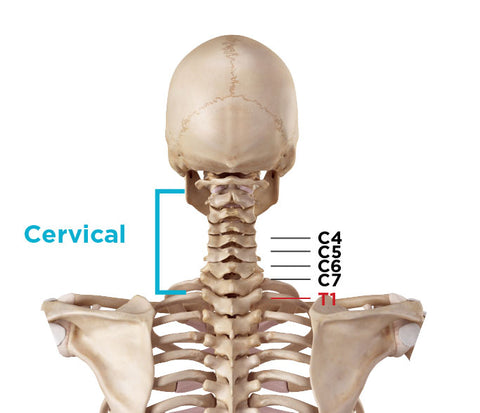
Symptoms of cervical spinal stenosis:
- Mild to intense neck pain
- Weakness in the neck or upper back area
- Hand clumsiness
- Burning, tingling, numbness in your neck, shoulders, arms, and hands (tingling in the hand is the most common symptom)
- Bladder or bowel issues (severe case)
Thoracic Spinal Stenosis
The least common type of spinal stenosis, thoracic spinal stenosis is a rare degenerative condition resulting in the spinal canal in the middle back area to become narrow.

Symptoms of thoracic spinal stenosis:
- Altered sensation in the lower body
- Pain or burning sensation in the thighs and calves
- Numbness, tingling, or weakness
- Pain worsens with movement
- Pain is contained and focused in one area, it doesn’t radiate anywhere else
Lumbar Spinal Stenosis
Lumbar spinal stenosis occurs in the lower back area of your spine and is the most common area for this condition. The lumbar area consists of five bones that connect with the thoracic spine area. This type is a result of the spinal canals narrowing and compressing on the nerves in your lower back into your legs. Although it is common in individuals over the age of 50 due to degeneration of the discs and joints, it can also be found in young individuals.
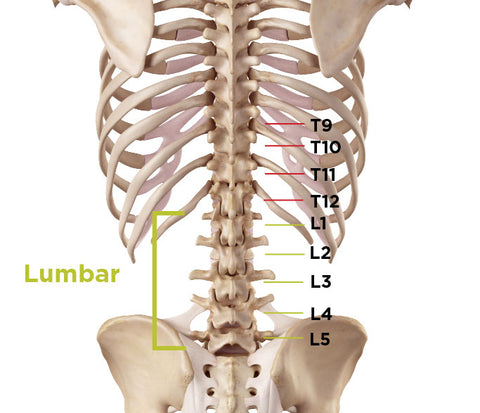
Symptoms of lumbar spinal stenosis:
- Mild to intense lower back pain
- Weakness in the legs or buttock area
- Balance and coordination problems
- Difficulty walking, standing, or bending over
- Burning, tingling, numbness in your lower back, buttocks, and legs
- Cramping in your legs after standing or walking for long periods
- Bladder or bowel issues (severe case)
How Is Spinal Stenosis Diagnosed?
Your doctor will diagnose your condition initially by learning more about your medical history and your symptoms leading up to your physical exam. Since spinal stenosis is similar to age-related conditions, diagnosing it can be difficult at times. Other ways doctors diagnose spinal stenosis:
- Tests: Muscle strength and sensation tests may be taken to help determine the severity of the pressure on your nerves.
- X-rays: To help detect any changes in the bone such as bone spurs to identify if there is narrowing in the spinal canal.
- MRI: Most common way to help diagnose spinal stenosis. MRI helps to detect any damage to the disc, ligaments, and to see if there are any tumors located in the spine. In addition, it can detect any pressure that may be put on the spinal cord and nerves.
- CT scans: Uses dye to outline the spinal cord and nerves to help detect herniated discs, bone spurs, and tumors.
How Can I Treat Spinal Stenosis?
Although spinal stenosis isn’t curable, there are numerous ways to help ease and alleviate your pain caused by the narrowing of the spine. Each treatment option depends on the location of your stenosis, severity, and cause of your specific spinal stenosis. It’s advised to speak with your doctor if your pain persists or causes extreme pain.
Some treatment options include:
- Anti-inflammatory medications: Help to reduce inflammation and swelling.
- Rest: It’s important to rest if you have spinal stenosis, overdoing an activity may make the symptoms worse and put more stress on your spine.
- Cortisone injections: Can be used in the spine to help reduce swelling.
- Physical therapy: Helps to strengthen and stretch your body’s muscles. In addition, physical therapy helps to increase your balance.
- Hot and cold therapy: Helps to reduce swelling and give pain relief.
- Bracing: These spinal braces can help support the spine to help relieve the pressure that is put on each area.
- Acupuncture: Used to stimulate different areas of the skin, helping to relieve lower back pain.
- Massage: Improves your range of motion.
- Weight loss: Carrying around extra weight may put more stress and pressure on the spine.
- Surgery: May be necessary for severe cases and can help to relieve the pressure permanently. There are three different types of surgery for the narrowing of the spine:
- Laminectomy: Most common, removal of part of the vertebrae to increase the space for the nerves.
- Foraminotomy: Helps widen the area around the vertebrae where the nerves exit.
- Spinal fusion: Usually for more intense cases, metal implants are used to attach the bones of the spine together.
Can I Exercise with This Condition?
Exercises and stretches can help ease your pain caused by spinal stenosis. It’s important to stray away from those exercises that may make your condition worse or cause more pain such as jogging for a long period of time, high impact sports, and walking or sitting for awhile. If you go to a physical therapist for your condition, you can learn different exercises to use at home to help increase your mobility and reduce your pain. Exercises that help extend and flex your spine can help to increase the size of your passageways to wear the nerves travel and exit the spine.
Here are some exercises for spinal stenosis:
- Biking
- Swimming or water walking
- Tai Chi
- Walking (only for a short period of time)
- Yoga helps to improve and correct your posture
- Stretches
- Back flexion: While lying on your back, pull your knees up to your chest for 30 seconds. Then repeat as necessary.
- Static stretch: While standing with your hands resting on your hips, lean backward gently as far as you can go. Hold this position for 20 seconds.
- Superman: Lie on your stomach with your hands shoulder-width apart. Push your core up and extend your arms and legs about six inches from the ground.
- Bridge stretch: Lie on the floor on your back with your knees bent and feet on the floor. Slowly raise your hips while moving your arms under your body. Push that position until you feel your spine stretched then hold that position up to 30 seconds.
- Read here for more stretches and exercises for treating spinal stenosis.









